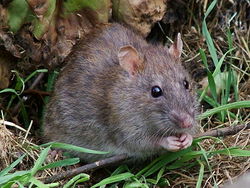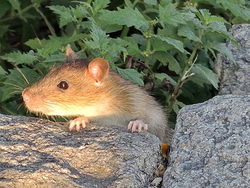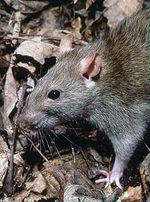Norway rat
| Norway rat |
|---|

|
| Scientific Classification |
|
| Scientific Name |
|
Rattus norvegicus |
| The Norway Rat, or Rattus norvegicus |
The Norway rat also referred to as Common Rat, Street Rat, Brown Rat, Brown Norway Rat, Norwegian Rat, or Wharf Rat is a species of rat known by the scientific name Rattus norvegicus. They typically have coarse, brown fur with a pale gray or grayish brown underside, and are perhaps best known as a destructive invasive species. They are believed to have first arrived in the United States on boats around 1776, likely brought over in boxes of grain by Hessian troops who were hired by Britain to fight the American colonists.[2]
Body Design
One of the largest muroids, it is a brown or grey rodent with a body up to 25 cm long, and a similar tail length; the male weighs on average 350 g and the female 250 g Thought to have originated in northern China, this rodent has now spread to all continents except Antarctica, and is the dominant rat in Europe and much of North America—making it by at least this particular definition the most successful mammal on the planet after humans. Adult Norway rats weigh an average of 1 pound.With rare exceptions, the brown rat lives wherever humans live, particularly in urban areas.
Life Cycle
The Rattus Norvegicus can be old enough to mate after two to five months of age, and can breed in any month of the year. They reproduce around 4 to 22 group of babies (litters) every year. The females can have around two to twelve litters every year. In the wild they tend to live around one year.[3]
When born, they are usually blind or naked (no fur). Since they grow quickly, they receive sight in about two weeks. They tend to slow reproduction rates in winter. The average life span when treated is around 2-3 years of age.[4]
Ecology
Rattus Norvegicus are originally native to Northern China [5], in lowland and coastal areas [6]. In Asia, Rattus Norvegicus are indigenous to forested and bushy areas. They commonly occur in colonies [7]. They prefer to hang around near and inside of human civilizations and manmade structures[5], as well as enjoying colder climates more than warm ones ( in which their activity and mobility is restricted )[8]. They are known to be territorial during the year, but it moves out when food becomes scarce. [9]
They are active mainly at dusk and nighttime, making them nocturnal, and they do so to forage for food, dig burrows, and prepare nests. Rattus Norvegicus make their shelters around water, and they make fantastic swimmers.[5]
Their food source may differ from garbage to eggs to young chicken, and tend to live in plant material.[4] Although they can eat from almost anything, they choose to go with fresh and wholesome foods, over rotten meat, or molded bread. They like to eat cereal grains, fruit, meat, fish, nuts, and eggs. The Norway Rats need at least half an ounce of water to survive through their habit of eating dry food.[10] These rats have been known to eat both plant and animal materials ( omnivore ), such as enjoying grains, and young poultry. This rat has even killed lambs and young pigs! [11] A study in New Zealand on Norway Rats reported that they ate invertebrates (beetles, spiders, wetas, and flies), fish, birds, vegetation, and a variety of shellfish. They are still classified as omnivores, however.[12]
Invasive Species
Location and Method of Introduction Norway Rats originated from Northern China. Around the early eighteenth century, this rat found its way to Eastern Europe. Then, in the nineteenth century, they started to populate in every European country. Now these rats can be found all around the world, except Antartica. [13] The Norway Rats were introduced to the states at 1775.
These Rats live relatively close to people. They tend to stay in places like storehouses, cellars, warehouses, and sewers, which are places that are usually uncleaned. The Norway Rat would sometimes even prefer a farm over the sewer, because they tend to live and eat plant type matter. If there is no free spot to stay for them, they can burrow under houses, or concrete, located around the river banks or ponds.[14]
Environmental Impact
Control Methods It is difficult to remove the rats once they have settled down in an area, even if it is only a few of them. Research has shown it is better to simply prevent them from entering in the first place.[15] An extreme example of removing a large population of Rattus Norvegicus was in Alberta, Canada, beginning in the 1950s. The province's control methods included, gassing, shooting, and poisoning of rats. Buildings infested with rats were subjected to being burnt down, and filled with poison.[16]
Video
References
- ↑ Rattus Norvegicus Wikispecies. Web. Accessed on November 3, 2016. Unknown Author.
- ↑ Brown rat Brown rat - Wikipedia. Web. Accessed on November 7, 2016.
- ↑ Norway Rat - Control & Identification Orkin International Web. accessed October 30, 2016. Author Unknown
- ↑ 4.0 4.1 Norway Rat Natural Science Research Laboratory at the Museum of Texas Tech University Web. Accessed on October 30, 2016. Unknown author
- ↑ 5.0 5.1 5.2 Armitage, David. Rattus Norvegicus Animal Diversity Web. Web. Accessed on November 3, 2016.
- ↑ Ruedas,L. Rattus norvegicus Rattus norvegicus. Web. Accessed on November 4, 2016.
- ↑ Linzey, Don. Rattus norvegicus Rattus norvegicus. Web. Accessed on November 4, 2016.
- ↑ Ruedas,L. Rattus norvegicus Rattus norvegicus. Web. Accessed on November 4, 2016.
- ↑ Rattus norvegicus GISD. Web. Accessed on November 7, 2016. Unknown Author.
- ↑ Timm, Robert. - Food Source Internet Center for Wildlife Damage Management. Web. Oct 30, 2005.
- ↑ Unknown Author. Norway Rat* Norway Rat*. Web. Accessed on November 4, 2016.
- ↑ Rattus norvegicus GISD. Web. Accessed on November 7, 2016. Unknown Author.
- ↑ Armitage, David. Brown Rat Geographic Range. Web. Accessed on Nov 7, 2016.
- ↑ Brown Rat Habitat and Location'. Web. Accessed on Nov 7, 2016.
- ↑ .Rattus norvegicus GISD. Web. Accessed on November 7, 2016. Unknown Author.
- ↑ Brown Rat Brown Rat - Wikipedia. Web. Accessed on November 7, 2016. Unknown Author.




